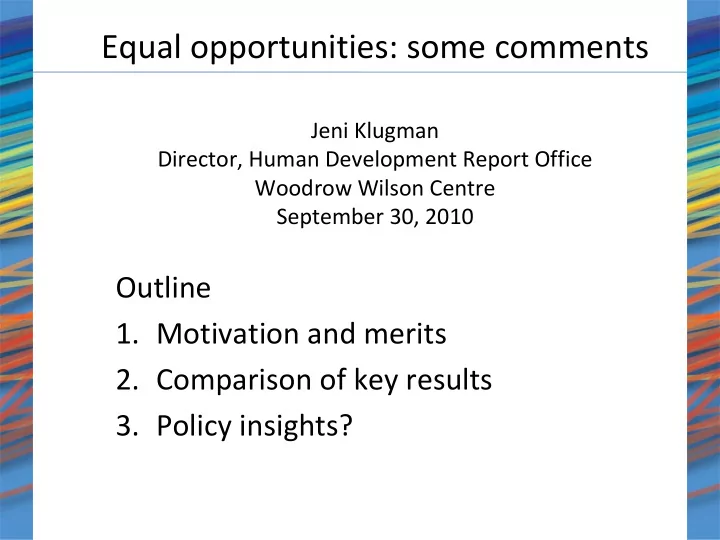

Equal opportunities: some comments Jeni Klugman Director, Human Development Report Office Woodrow Wilson Centre September 30, 2010 Outline 1. Motivation and merits 2. Comparison of key results 3. Policy insights?
Approach welcomed • Motivation grounded in capabilities approach: seeking to expand people’s real freedoms ‐ • Presented as a way to monitor the equity of access to key services important for a child to succeed in life ‐ > new human opportunity agenda • Multidimensional • Systematic use of micro ‐ data • Responsive to public interest and policy demand • Stimulate discussion and debate
Questions about the approach • Very unequal outcomes are potentially compatible with an EoO principle • Methodological issues: – Is it valid to separate effort from circumstances if they are statistically correlated? (endogeneity) – How to define circumstances/types? (correlation with poor outcomes? Overall consensus? Stereotypes?): empirical question or normative decision? – Where should the “starting gate” be placed ? – Not sub ‐ group consistent (Foster and Lopez) – cf Inequality adjusted HDI • Need to recall what is missing: – Due to method • Concurrent/ overlapping circumstances – eg girl in poor family • Overlapping deprivations – eg no school and no electricity • Process freedoms – eg Costa Rica vs Cuba – Data/ indicators constraints: • Key circumstances – eg migrant status • Other key inequities – eg health, nutrition … • Measurement of education limited to basic levels
Comparison of key results • Innovations in the HDR family of indicators, complementary to the HDI: – Inequality ‐ adjusted HDI – discounts the average level of human development due to inequality in health, education and income. – Gender Inequality Index (GII) – captures losses national achievement due to gender disparities in economic participation, health and education (association sensitive). – Multidimensional Poverty Index (MPI) – identifies serious overlapping deprivations in health, education and living standards • Applied to between 104 (MPI) to 138 (IHDI and GII) countries
Comparison of key results: LAC LAC Developed East Asia Best/ worst in LAC (N) overall HOI 77 Chile/ Honduras (18) IHDI (loss) 26% 10% 22% Bahamas/ Haiti (25) GII 61 32 46 Cuba/ Haiti (25) MPI 10.4% 0.6% 13.7% Uruguay/ Haiti (18) headcount $ 1.25 a day 6.9% 17.6% Chile/ Haiti (20) poor Note differences in country sample
Comparison of rankings: LAC HOI IHDI (loss) GII MPI headcount $ 1.25 poor 1Chile Bahamas Barbados Uruguay Chile 2Uruguay Trinidad and Tob. Trinidad and Tob. Ecuador Costa Rica 3Mexico Uruguay Cuba Argentina Jamaica 4Costa Rica Jamaica Costa Rica Mexico Uruguay 5Venezuela Guyana Chile Belize Argentina 6Argentina Chile Uruguay Trinidad and Tob. Venezuela 7Jamaica Ecuador Argentina Suriname Mexico 8Ecuador Costa Rica Venezuela Brazil Dominican Rep. 9Colombia Mexico Mexico Colombia Ecuador 10Brazil Venezuela Belize Dominican Rep. Brazil 11Dominican Rep. Suriname Peru Paraguay El Salvador 12Paraguay Nicaragua Brazil Guyana Paraguay 13Panama Paraguay Panama Peru Peru 14Peru Dominican Rep. Jamaica Guatemala Panama 15Guatemala Brazil Paraguay Honduras Guatemala 16Nicaragua Argentina Ecuador Bolivia Bolivia 17Honduras El Salvador Dominican Rep. Nicaragua Nicaragua 18 Panama El Salvador Haiti Colombia 19 Colombia Colombia Honduras 20 Belize Guyana Haiti 21 Honduras Bolivia 22 Peru Nicaragua 23 Guatemala Honduras 24 Bolivia Guatemala 25 Haiti Haiti
Policy insights? • The new human opportunity agenda … a rich agenda remains to be investigated… – Diversity of best performers Chile, Uruguay, Mexico, Costa Rica and Venezuela – noted but not explored in terms of institutions and policies • Routes to improvement – Circumstances – validity dismissed/ disparaged – ‘takes too long…’ BUT income transfers can be very effective (HDR09) If many circumstances cannot be affected: how can we guarantee EoO? – Scale (conventional route) – Equalisation – targeted programs
Recommend
More recommend